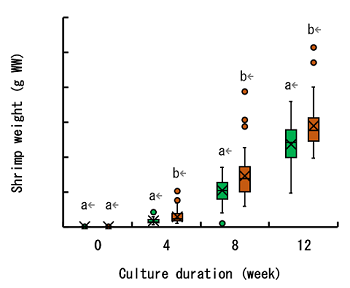Use of a filamentous green alga (Chaetomorpha sp.) and microsnail (Stenothyra sp.) as feed at an early stage of intensive aquaculture promotes profitability of giant tiger prawn
Description
Shrimp is a major export item; hence, high Penaeidae shrimp production in intensive aquaculture systems contribute to the economic development of shrimp-producing countries. However, decreasing shrimp productivity and profitability have been reported owing to a deterioration in artificial feed quality and the soaring prices of artificial feed. Following a series of research activities on Penaeidae aquaculture in Southeast Asian countries, JIRCAS was able to develop a simple, low-cost, and sustainable technique to boost productivity, feed efficiency, and profitability of the giant tiger prawn. The aim of this study was to verify the profitability of giant tiger prawn grown in an innovative aquaculture system, in which a filamentous green alga (Chaetomorpha sp.) and microsnail (Stenothyra sp.) are cultured together during early stage and freely consumed as supplementary live feeds in intensive aquaculture ponds.Post-larvae (mean wet weight: 2 mg, mean total length: 9 mm) of giant tiger prawn were released and cultured at a density of approximately 33 individuals m–2 in outdoor concrete ponds (9 m×9 m×1.2 m) at King Mongkut’s Institute of Technology Ladkrabang (KMITL), Thailand, under either control (fed only artificial feed, n = 3) or experimental (fed artificial feed and benthic organisms, n = 3) conditions (Fig. 1) until they reached marketable size (15 weeks) (Fig. 2, Table 1). Compared with the control group of giant tiger prawn, the experimental group significantly improved in terms of productivity (33%), feed efficiency (12%), and profitability (46%) when provided ~8% green alga to total feed consumption and ~2% microsnail to total feed consumption at an early stage of culture. The individual shrimp weight became significantly higher in the experimental treatment ponds (median: 1.12 g, mean: 1.44 g) than those in the control ponds (median: 0.70 g, mean: 0.80 g) at week 4. The technique developed in this study will help enhance productivity, feed efficiency, and profitability in intensive giant tiger prawn aquaculture operations.
From these results, it is expected that this can be applied to Penaeidae intensive aquaculture management systems other than those for giant tiger prawn. Both green alga, Chaetomorpha sp., and microsnail, Stenothyra sp., were all consumed within 1–2 months due to active grazing by the giant tiger prawn. These two benthic organisms could be propagated for longer periods in shrimp culture ponds for higher productivity, feed efficiency, and profitability.
Figure, table
-
Fig. 1. Post-larvae (Total length: ~9 mm, yellow arrows), Chaetomorpha sp. (area within dark blue broken line) and Stenothyra sp. (red arrows)
-
Fig. 2. Sorting operation at a shrimp broker company for giant tiger prawn produced from this study
-
Table 1. Results of the 15-week giant tiger prawn aquaculture experiment in a concrete pond at KMITL
Control (n = 3) Experimental treatment (n = 3) Growth and productivity Final mean individual shrimp weight (g WW) 16.0 ± 0.61 18.2 ± 1.07 * Total shrimp production (kg WW) 33.0 ± 1.8 43.9 ± 0.5 * Feed intake and efficiency Apparent Chaetomorpha intake (kg WW) ― 6.81 ± 1.45 Apparent Stenothyra intake (kg WW) ― 1.96 ± 0.05 Apparent artificial feed intake (kg WW) 61.0 ± 3.2 72.0 ± 3.8 * Feed efficiency (%) 54.1 ± 1.8 61.1 ± 4.0 * Costs and profitability Artificial shrimp feed costs (USD) (a) 83.55 ± 4.45 98.59 ± 5.24 * Miscellaneous costs (USD) (b) ― 12.11 ± 0.00 Shrimp sales (USD) (c) 155.73 ± 10.27 215.97 ± 4.37 * Balance between shrimp sales and costs (USD) (c-a-b) 72.18 ± 7.55 105.27 ± 3.02 * Values are shown as mean ± standard deviation from triplicate data. Superscript labels within the same row indicate significant difference (t-test, p < 0.05). Feed efficiency (%) is calculated as 100 × weight gain / Feed amount intake. Common costs between mono-culture and co-culture such as water charges, electric fees, labor, culture materials, etc. are omitted in order to easily compare the profitability results.
-
Fig. 3. Changes in wet weight of giant tiger prawn under control (green) and treatment (orange) conditions
Different lowercase letters within the same sampling week indicate a significant difference between treatments (Mann-Whitney U-test, p < 0.05, adjusted via the Bonferroni correction for multiplicity)
- Affiliation
-
Japan International Research Center for Agricultural Sciences Fisheries Division
- Classification
-
Research
- Research project
- Program name
- Term of research
-
FY2020(FY2016~FY2020)
- Responsible researcher
-
Tsutsui Isao ( Fisheries Division )
KAKEN Researcher No.: 80425529Aue-umneoy Dusit ( King Mongkut's Institute of Technology Ladkrabang )
- ほか
- Publication, etc.
-
Tsutsui et al. (2020) PLOS ONEhttps://doi.org/10.1371/journal.pone.0244607
- Japanese PDF
-
2020_C09_A4_ja.pdf588.92 KB
2020_C09_A3_ja.pdf583.64 KB
- English PDF
-
2020_C09_A4_en.pdf434.35 KB
2020_C09_A3_en.pdf436.02 KB
- Poster PDF
-
2020_C09_poster.pdf435.61 KB
* Affiliation at the time of implementation of the study.

